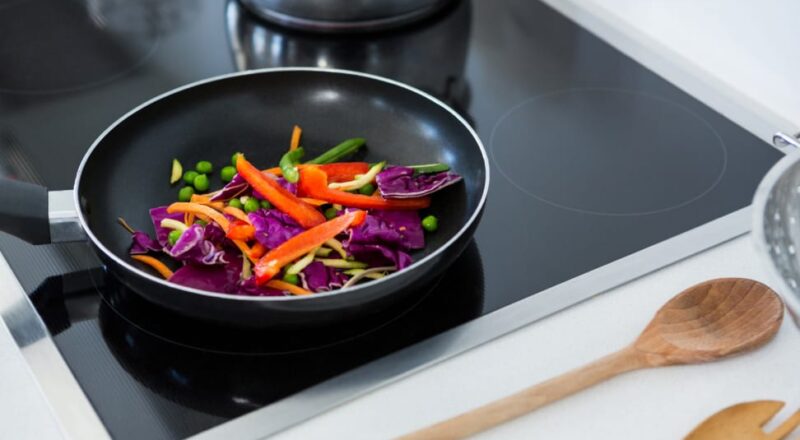Induction cooking has revolutionized the modern kitchen with its efficiency and precision. However, one of the primary concerns for many is minimizing cleanup after induction cooking. In this article, we will explore practical tips and strategies to make cleaning up after your culinary adventures a breeze.

Understanding Induction Cooking
Before diving into cleanup strategies, it’s essential to understand how induction cooking works. Unlike traditional cooking methods, induction uses electromagnetic fields to heat pots and pans directly, which means the cooktop itself remains relatively cool. This unique feature can significantly reduce spills and messes.
Choosing the Right Cookware
One of the first steps in minimizing cleanup is to select the right cookware. Opt for pots and pans that are compatible with induction cooktops, such as those made from cast iron or stainless steel. Proper cookware not only enhances cooking efficiency but also minimizes the likelihood of spills.Cast Iron vs Glass cookware on induction can be a great start.
Regular Maintenance of Cookware
Maintaining your cookware is crucial. Ensure that the bottoms of your pots and pans are clean and dry before placing them on the cooktop. This practice helps prevent residue buildup and ensures even heating, reducing the risk of spills.Cast Iron Heating evenly is key.
Using Cooktop Covers
Cooktop covers can be a game-changer in minimizing cleanup. These protective layers sit atop your induction cooktop, catching any spills or splatters. They are easy to remove and clean, making them a convenient addition to your kitchen.
Selecting the Right Cover Material
When choosing a cooktop cover, opt for materials that are heat resistant and easy to clean. Silicone covers are a popular choice due to their durability and non-stick properties.
Adopting Smart Cooking Practices
Smart cooking practices can significantly reduce the mess. For instance, using lids on pots and pans can prevent splatters. Additionally, stirring food regularly and adjusting heat settings can minimize the risk of spills.
Proper Temperature Control
One of the advantages of induction cooking is precise temperature control. Utilize this feature to maintain optimal cooking temperatures, reducing the chance of food boiling over or burning.
Cleaning as You Go
Adopting a ‘clean as you go’ approach can make cleanup much more manageable. Wipe up small spills immediately to prevent them from hardening and becoming more challenging to clean later.
Utilizing Microfiber Cloths
Microfiber cloths are excellent tools for quick cleanups. Their absorbent and non-abrasive nature make them perfect for wiping down induction cooktops without scratching them.
Regular Deep Cleaning
Beyond daily maintenance, schedule regular deep cleanings of your induction cooktop to keep it in top condition. Use gentle cleaning agents and avoid harsh chemicals that might damage the surface.
Homemade Cleaning Solutions
Consider making your own cleaning solutions using natural ingredients like vinegar and baking soda. These substances are effective in removing stubborn stains and grease without leaving harmful residues.
Dealing with Stubborn Stains
Sometimes, despite your best efforts, stubborn stains may occur. Use a plastic scraper or a specialized cooktop cleaner to remove these without scratching the surface.
Preventative Measures
To prevent stubborn stains, always clean your cooktop immediately after cooking. This practice helps prevent food from hardening and becoming more difficult to remove.
Benefits of Induction Cooking
Aside from minimizing cleanup, induction cooking offers numerous benefits, such as energy efficiency and faster cooking times. These advantages make it a worthwhile investment for any modern kitchen.
Energy Efficiency
Induction cooktops are highly efficient, transferring energy directly to the cookware. This efficiency translates to lower energy bills and a reduced carbon footprint.
Time-Saving
With faster heating times, induction cooking can significantly reduce meal preparation time, allowing you to enjoy more leisure time with family and friends.
Embracing a Cleaner Kitchen Lifestyle
By implementing these strategies, you can enjoy a cleaner, more efficient kitchen. Embrace the benefits of minimizing cleanup after induction cooking and discover the joy of effortless post-cooking maintenance.
For more on using cast iron on induction cooktops, check out this insightful article.

FAQs
How do I prevent scratches on my induction cooktop?
Use cookware with smooth bottoms and avoid sliding pots and pans across the surface. Employing cooktop covers can also help.
Can I use cast iron on induction cooktops?
Yes, cast iron is compatible with induction cooktops. For more information, visit Lodge Cast Iron.
What cleaning products are safe for induction cooktops?
Use non-abrasive cleaners specifically designed for induction cooktops. Avoid products containing harsh chemicals or abrasives.
This article contains affiliate links. We may earn a commission at no extra cost to you.

